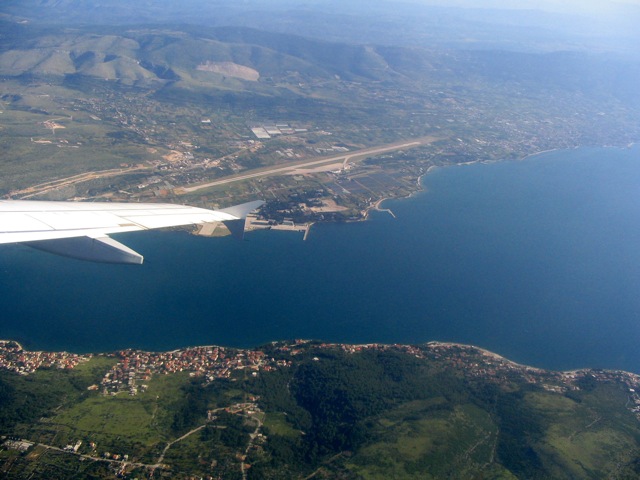
SOUTHERN APPROACH TO THE SPLIT AIRPORT
It was windy and rainy on the Dalmation coast. Joe was right on time to pick me up at the Split Airport terminal. We immediately drove 5km to one of his hangouts in the small town of Kastela. It was right on the water down windy narrow side streets. I was an immediate curiosity to his friends who had known I was coming. They could all speak English and were very gracious. Other locals made a point to come over and talk to the group so they could gawk at the American. Joe versed me on some finer points of Croatian etiquette. One person pays for a round of drinks, you always share cigarettes when someone asks, and you never pull out your money to pay until it is time to leave.
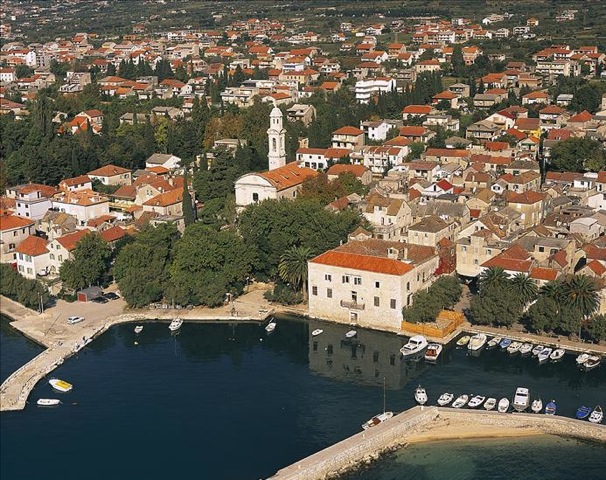
KASTELA
Joe is quite well-known, if not infamous, in a three-town area and has made many friends. He is the only American that lives there and he is the only American in the country that owns a Croatian-registered vehicle. One reason he is accepted is that he has Croatian roots via his grandmother on his mother's side. He would like to apply for Croatian citizenship in several years.
We decided to go to Split to do a financial transaction at Joe’s bank and to show me the city. The rain was getting more intense and the windshield wipers on Joe's car did not work so we decided to take a bus. On the 13km trip the bus passed several factories and a marble quarry. It stopped raining when we got to the bus station and we proceeded on foot to downtown.
Split is no ordinary city. its core is built upon the ancient palace of the Roman emperor Diocletian, circa 300 ad. At one juncture you walk through a dungeon-like corridor then it suddenly opens up into a courtyard. Small cobblestone side-streets funnel you into other parts of the palace occupied with shops and into other courtyards surrounded by marble pillars. An ancient church occupies the center of one of these courtyards.
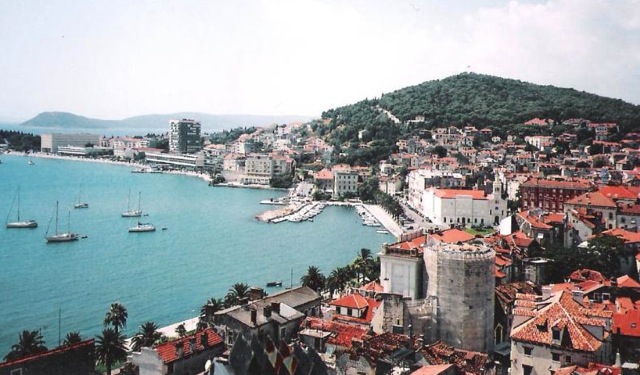
COASTAL CITY OF SPLIT
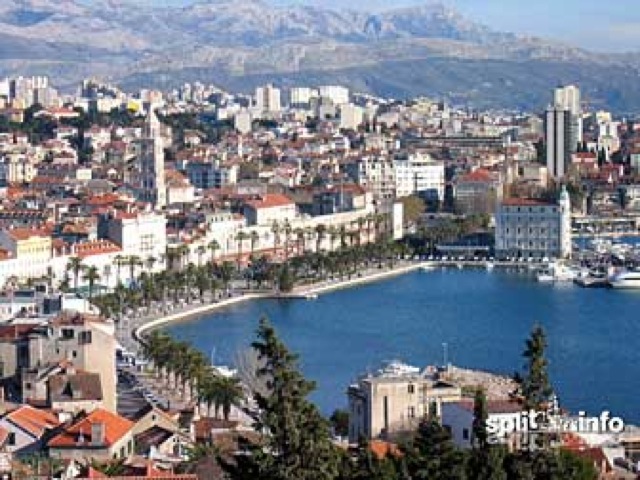
Palm trees and sidewalk cafes line the avenue along the harbor which is a jumping off spot for cruise ships and ferries.
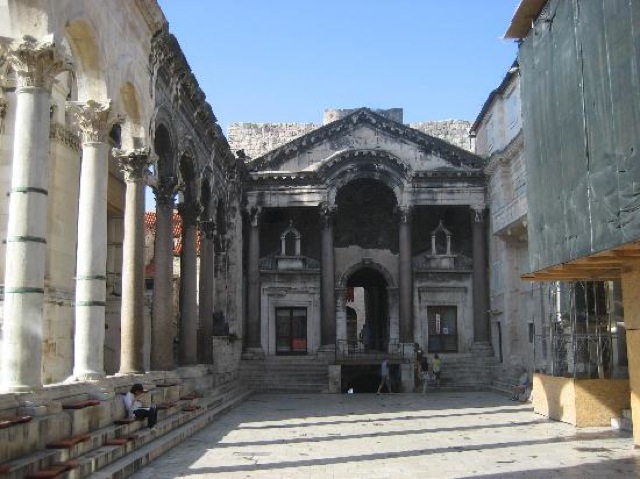
DIOCLETIAN'S PALACE
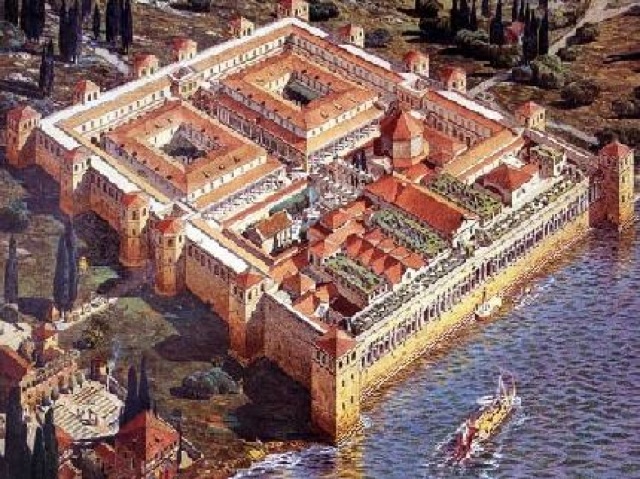
THEN (4th CENTURY A.D.)
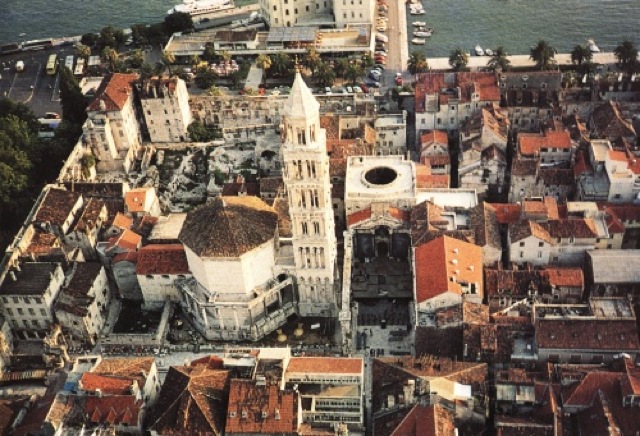
NOW
Most of Dalmatia, the southern region of Croatia along the Adriatic Sea, is a summer tourist attraction for northern Europeans who come to enjoy the hot sun and warm blue waters. Split is the center of the country's tourist trade and the major transportation center for all the surrounding resort towns. The country is making further efforts to induce tourism to help its economy. I predict one day you will see TV ads in the U.S. promoting travel to Croatia.
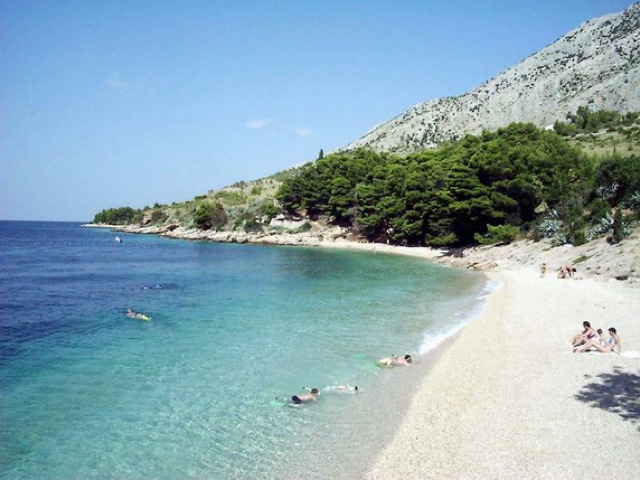
TYPICAL BEACH IN DALMATIA
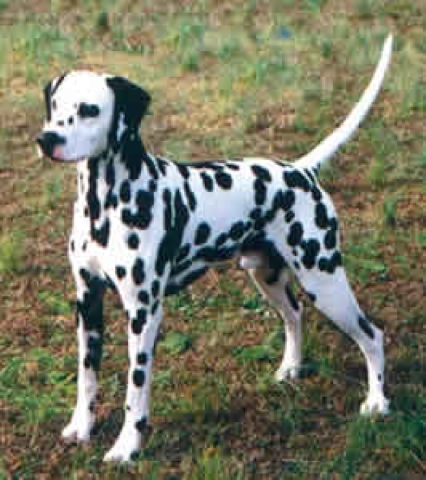
TYPICAL INHABITANT OF DALMATIA
It was starting to get dark as we headed back on the bus to Kastela. Although it was still warm it began to rain heavily with bursts of thunder and lightning. We arrived where Joe had parked his car, a 1980's Serbian-made piece of junk that his friends call the "Chetnik Cadillac". The lack of windshield wipers made driving a dangerous adventure. We stopped off at a "fast food" place and bought some cevapcici, sausage sandwiches made with large chewy bread that are the Balkan equilvalent to our hamburgers.
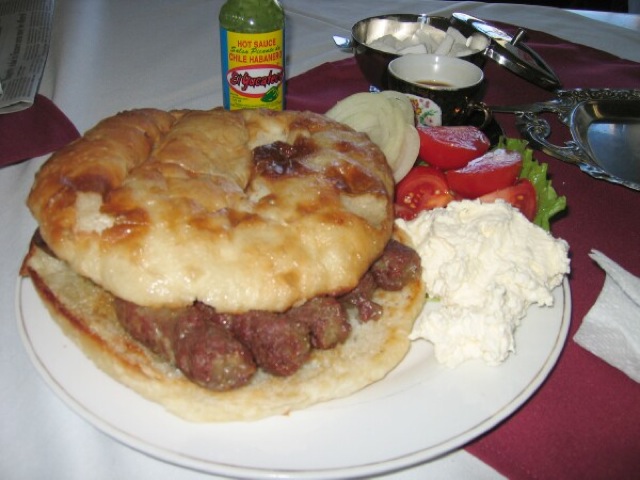
CEVAPCICI
(Ours didn’t have near this much sausage.)
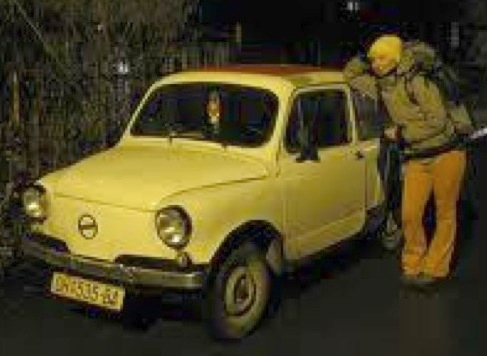
CHETNIK CADILAC
Joe and his girlfriend, Margie, live on the island of Ciovo, a few miles past the town of Trogir. They pay $130 a month (including electricity) for a two-bedroom flat which occupies the lower floor of a house right across the road from a rocky beach on the Adriatic Sea.
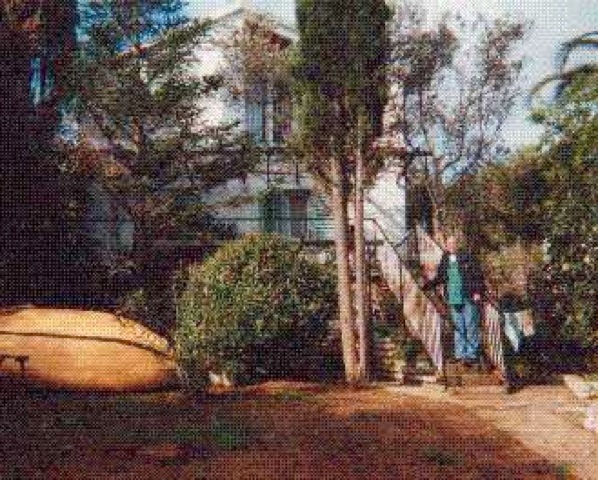
JOE & MARGIE'S HOUSE

SCENE FROM JOE & MARGIE'S HOUSE
Day 4, Thursday, March 30
We slept in past noon, having stayed up the night before drinking wine and playing cards. Joe is in the business of raising chinchillas so we had to go check up on them. They were located at the home of his business partner, Marin who lives with his mother. It was a typical block house which turned out to be quite cozy on the inside. Marin's mother showered me with hospitality and fed us a lunch consisting of--meat, cheese, crackers, an orange drink that tasted like Tang, Turkish coffee, and home-made raspberry wine. Marin gave me one of his pieces of art, a painting of traditional Croatian folk dancers on clear glass. He sells these in many of the souvenir shops in the area.
Raising chinchillas is a cottage industry in Dalmatia. Joe and Marin's one hundred-or-so chinchillas were kept in the unfinished top floor of the house. Females are kept in separate cages while a male is free to roam and to enter the cages of the females to mate. (Sounds good to me!) Feeding and temperature must be carefully maintained to insure good health. Joe and Marin were going to make many new cages upon expectations of their breeding. They sell the live adult chinchillas to a buyer who then sells them in France. (Chinchilla meat is often passed off as rabbit in French restaurants--yum yum.)
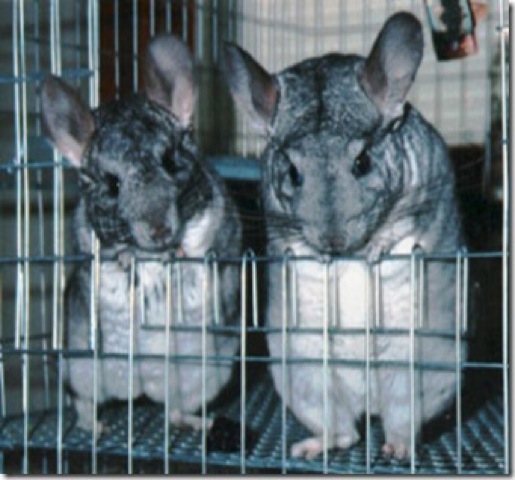
WOULD YOU LIKE FRIES WITH THOSE CHINCHILLAS?
After tending to the rodents we decided to go to Split again. By now it was warm and sunny so wipers were not an issue. We had a beer in a pub, I bought some strings for Joe’s Ovation guitar at a music store, and we bought a bottle of Rain-X at an auto parts store to repel water from Joe’s windshield. No doubt that bottle would outlast the Chetnik Cadilac.
Late in the afternoon we drove northeast of the city to Twierdza Klis, a historic castle on the crest of a hill. We paid the drunk gatekeeper 10kn each and entered. For an hour and a half we were the only two people there as we explored the huge fortress. It had been used as a defense as recently as world war two and the walls and some buildings were still intact. Napoleon had been here during his conquests and I actually sat on the stone toilet that he sat on.
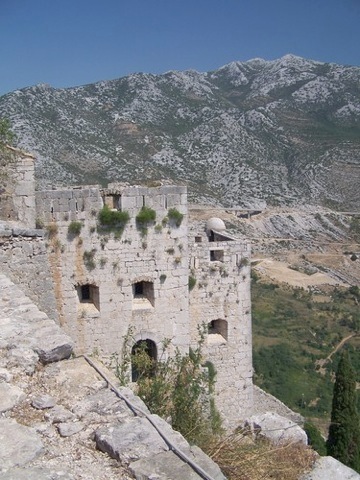
TWIERDZA KLIS (home of Napoleon’s throne)
On our way home we stopped at another of Joe's hang-outs, an old picturesque stucco bar with an outside courtyard. It was owned by an Australian that had fought there during the war and since has become a Croatian citizen. The people were very friendly and curious. 70's and 80's rock music was being played over the speakers, unusual because everywhere else played that soulless techno crap. Live music is rare in Croatia and Joe and I fantasized with about starting a vintage rock band and becoming big Croatian stars.
Next stop was the "supermarket". Although most grocery stores are "mom and pop" holes-in-the-wall this store was a large cement block building with a parking lot that accommodated about ten cars. (We were one of three.) Inside were three aisles about 100 feet long. Shelves were stocked with products from different European countries as well as from the U.S. (Gillette, Shick, Nestle's, Snicker's...) The selection of produce was minimum and was of poor quality. (Most people buy produce daily in public markets.) The milk was not refrigerated and came in small rectangular boxes. After being stared at by the patrons and employees we made our purchase. By then it was past 9 pm and we had one more stop. We drove several miles up the coast to a shell-fish farm and bought fresh muscles right off the dock. Two kilos (4.4 lbs.) cost 10kn (about $1.25). Margie and Joe boiled the muscles and made pasta with white sauce. It was a feast.
Day 5, Friday, March 31
Margie, Joe, Elvis (their German Sheppard), and I piled into the Chetnik Cadillac and drove southeast through the town of Slatine, to the end of Ciovo Island. Most roads are very narrow, especially through towns. (Two large American cars could never pass each other.) The road turned to dirt as it wound up into abandoned olive orchards surrounded by stone walls. We parked and proceeded a half mile by foot on a well worn path on the edge of the cliff. Here was the Gospa od Prizidnca, a small stone church built in 1546. Once a year people walk to this church from the town carrying banners in a religious celebration. We took the path all the way down to the water and sunned ourselves on the rocks. Elvis loved it.
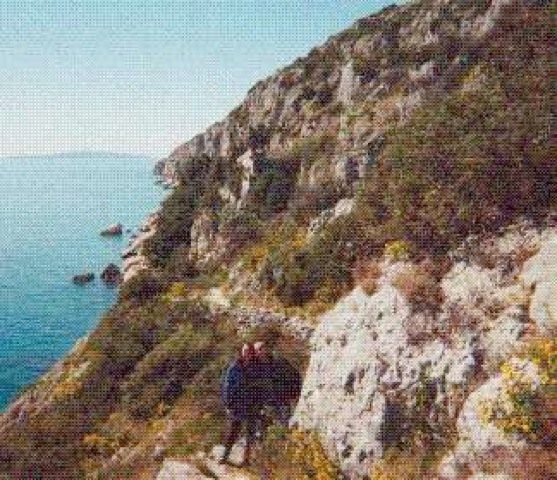
JOE AND MARGIE ON THE PRECARIOUS PATH

SALVATION AT LAST!
Next stop was Trogir, a walled medieval town surrounded by the bay and a moat. It has winding cobblestone streets, too narrow even for small European automobiles. There are many shops, cafes, and residences and at the far corner of the town is an ancient fortress that is now a grade school. We stopped and had pizza and beer at a busy sidewalk cafe. European pizzas are served one per person. They have a thin crust, sparse toppings (especially meat), and you have to cut it yourself. Also, Europeans eat pizza with a fork! After eating pizza in three countries I must say American style pizza is the best.
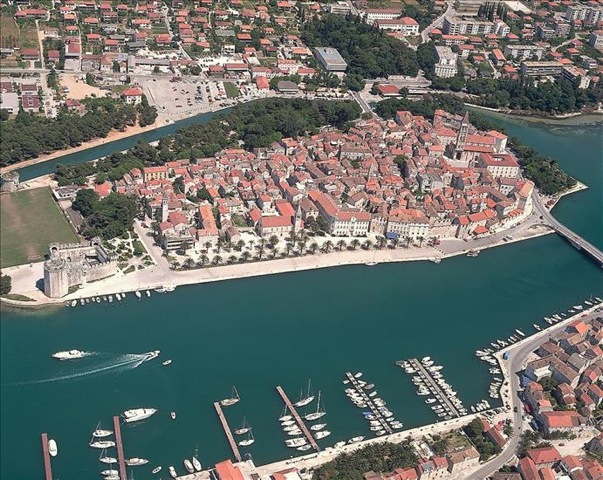
TROGIR

TROGIR
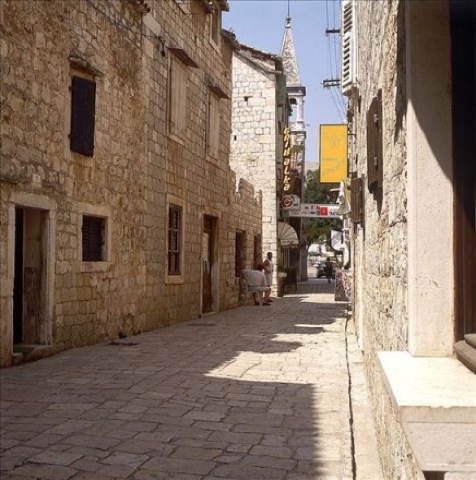
NO CARS ALLOWED
Day 6, Saturday, April 1
It was April Fool's Day and the Split newspaper announced that Dennis Rodman was going to play for the Split basketball team.
Margie had told me about her recent two-week trip down the coast to Dubrovnik. She had also visited the island where her grandmother was born and had stayed in a sobe, a rented room in a private residence. (Upon arrivals at train and bus stations there are always people offering rooms to tourists. Most sobes are about $7-$8 per night and sometimes include meals.) I made a decision to leave the next day for Dubrovnik, about 120 miles south.
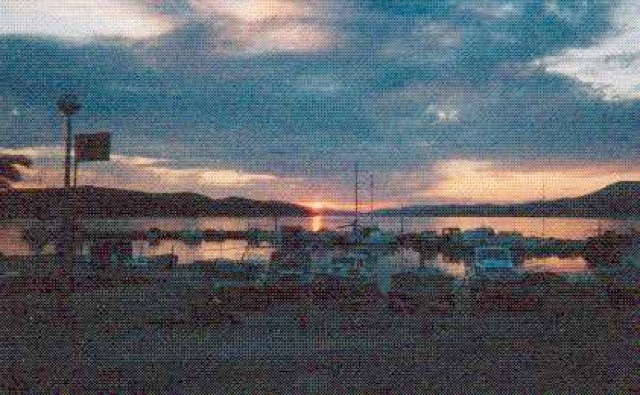
ADRIATIC SUNSET
|